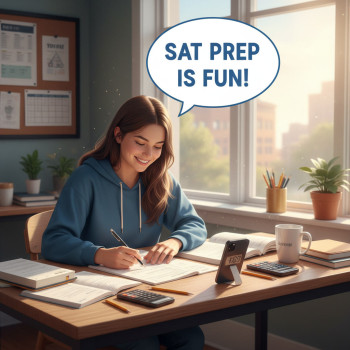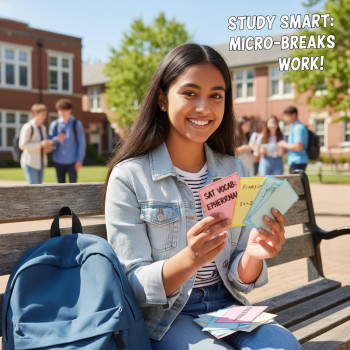Why Yoga Belongs in Your SAT Prep Toolkit
If the words “SAT” and “stress” describe two corners of the same room in your mind, you’re not alone. Preparing for the Digital SAT is a marathon of focus, strategy, and—yes—emotional resilience. That’s where yoga comes in: not as a magic pill, but as a reliable, science-backed set of tools that can steady your breath, sharpen your attention, and help you show up calmer and clearer on test day.
This post is for students who want practical, realistic ways to weave yoga and mindfulness into busy study schedules. You’ll get short routines you can do between practice sections, breath exercises for pre-test nerves, a sample weekly plan that balances study and self-care, and a quick look at how Sparkl’s personalized tutoring can dovetail with your wellness routine to produce better outcomes—without turning your life into a rigid regiment.
How Yoga Helps When You’re Studying for the SAT
1. Reduces physiological stress
Stress is as much bodily as it is mental. Yoga practices—especially breath work and gentle stretching—engage the parasympathetic nervous system (the body’s “rest-and-digest” mode) and lower the fight-or-flight hormones that make you feel scattered. A calmer body means fewer racing thoughts during a timed math section or a reading passage.
2. Improves focus and cognitive flexibility
Short yoga sequences and mindfulness drills train your attention to return to one task—breath, posture, or an object—over and over. That repetition improves focus stamina. For the SAT, which requires switching between problem types and sustaining attention through long sections, this is an underrated advantage.
3. Helps with sleep and memory consolidation
Good sleep is the unsung hero of test prep. Gentle yoga and calming breathing before bed can shorten the time it takes to fall asleep and improve sleep quality, which in turn aids memory consolidation—especially for vocabulary, formulas, and strategies you practiced earlier in the day.
4. Builds emotional resilience
Yoga encourages a nonjudgmental relationship with experience: noticing a thought or feeling and letting it pass. During practice, you learn to meet challenge without overreacting—exactly the mindset that helps when you stare at a tricky SAT problem and feel that familiar panic rising.
Quick Yoga Tools You Can Use Between Practice Sections (5–10 minutes)
Short practices can be surgical: they interrupt stress, reset posture, and bring attention back to the present. Here are 5 quick sequences you can use during study breaks or between Digital SAT sections when you’re allowed a screen break or a few minutes in the hallway.
1. Three-Minute Reset: Sit, Breathe, Ground
- Find a chair or sit on the floor.
- Place both feet on the ground (if seated) and soften your shoulders.
- Inhale for 4 counts, hold for 1, exhale for 6 counts. Repeat 6 times.
- Scan your body from head to toe and release any jaw or shoulder tension.
Outcome: instant parasympathetic activation and clearer thinking for the next practice block.
2. Five-Minute Mobility: Open the Chest, Protect the Neck
- Shoulder rolls: 8 forward, 8 back.
- Cat–Cow (on hands & knees or seated variation): 8 rounds to mobilize the spine and ease back tension from long hours at a desk.
- Seated twist: 3 breaths each side to wring out built-up mental tension.
3. Standing Energizer: 6-Minute Flow
- Mountain pose (Tadasana)—2 breaths to find alignment.
- Sun A mini-series: Forward fold, half lift, gentle lunge—2 rounds.
- Tree pose (Vrksasana) for balance—30 seconds each side.
Outcome: increased circulation, more oxygen to the brain, and a calmer heart rate before you get back to questions.
Breathwork for Immediate Test-Day Calm
Practice these breathing techniques during your prep so they’re automatic on test day. Each one is short and discreet—perfect for a testing center bathroom stall, a quiet corner, or while you wait for your Digital SAT section to load.
Box Breathing (4-4-4-4)
- Inhale 4 counts, hold 4, exhale 4, hold 4. Repeat 6–8 cycles.
Why it helps: This pattern stabilizes breathing and produces a calm, rhythmic focus—great when your hands get sweaty before the calculator section.
4-2-6 Extended Exhale
- Inhale 4 counts, hold 2, exhale 6. Repeat 8–10 cycles.
Why it helps: Extending the exhale nudges the parasympathetic nervous system and calms acute anxiety faster than a long inhale.
Nasal Alternate Breathing (Nadi Shodhana) — Practice Before the Exam
- Close right nostril with thumb, inhale left. Close left with ring finger, exhale right. Reverse. Repeat 8 rounds.
Why it helps: This technique balances the nervous system and steadies emotion. Practice it a few times during your week of prep to make it familiar.
A Simple Daily Routine That Fits Intense Study Weeks
When you’re juggling practice tests, school, and life, routines must be realistic. Below is a plan students can follow for a week when SAT practice ramps up. It balances active study, yoga, and recovery so you don’t burn out before the test.
| Time | Action | Why It Works |
|---|---|---|
| Morning (20–30 min) | Gentle yoga flow + 5-minute breath practice | Wakes the body, primes focus, reduces morning stress |
| Study Block 1 (60–90 min) | Targeted SAT practice (timed) | Highest-focus work when energy is fresh |
| Break (10 min) | 3-minute reset breathing + light mobility | Prevents mental fatigue, improves circulation |
| Study Block 2 (60–90 min) | Skills work: grammar rules, math strategies | Builds technique and efficiency |
| Evening (15–20 min) | Calming yoga + restorative breathing; digital detox 30 min before bed | Prepares brain for sleep and memory consolidation |
Outcome: You get focused study sessions without creeping exhaustion or chronic anxiety—two of the biggest productivity killers for SAT preparation.
Exercises to Target Common SAT Prep Pains
Below are short practices focused on symptoms many students report while preparing for the test.
Neck and Shoulder Tension (from hours at a laptop)
- Neck rolls—slow circles, 6 each direction.
- Thread-the-needle—hold 30 seconds each side.
- Chest opener against a wall or doorway—2 breaths per side.
Racing Heart/Pre-Test Panic
- 4-2-6 extended exhale for 2–3 minutes.
- Seated forward fold for 5 deep breaths to cue rest.
Mental Fatigue and Fog
- Alternate nostril breathing—8 rounds.
- Standing mountain to chair flow (engages legs and core) to re-energize circulation.
How to Make Yoga Stick—Practical Discipline Over Perfect Practice
Consistency beats intensity for long-term results. Here are realistic tips to build a habit without guilt:
- Keep sessions short: 5–20 minutes is often enough.
- Anchor practice to a daily habit: after breakfast, or before your last study block.
- Track it lightly: a small checkmark on a calendar is more effective than an all-or-nothing approach.
- Make it social: invite a friend or partner to do a 10-minute routine together before a practice test.
When to Use Yoga vs. When to Use Other Tools
Yoga is a powerful complement, not a replacement, for other proven SAT prep strategies. Here’s how to decide what to use when.
- If you’re distracted or anxious between questions: stop for a 1–3 minute breath practice.
- If you’re mentally exhausted: use gentle restorative yoga and a short nap rather than pushing more timed practice.
- If you’re stuck on a concept: switch to targeted practice or ask a tutor for help—yoga helps clarity, but it won’t teach algebraic manipulation.
Sample Week: Combining Yoga with High-Quality Prep
Below is a sample schedule that blends study, practice tests, yoga, and rest. Tailor the timing to your school and life commitments.
| Day | Morning | Afternoon/Evening |
|---|---|---|
| Monday | 10-min yoga flow + focused reading practice (60 min) | Targeted math skills (60 min) + 5-min breath reset |
| Tuesday | 5-min breathing + timed section (Reading) | Review mistakes + restorative yoga (15 min) |
| Wednesday | Core flow (15 min) + practice problems | Full-length practice section or mixed questions |
| Thursday | Alternate nostril breathing + vocab strategies | One-on-one tutoring check-in (if available) + evening calming yoga |
| Friday | Light flow + short practice test | Social unwind: yoga with a friend or group session |
| Saturday | Full practice test (simulate testing conditions) | Recovery: restorative yoga and digital detox |
| Sunday | Easy movement + planning for next week | Prepare materials, sleep early |
Note: One-on-one tutoring sessions can be positioned strategically (for example, Thursday afternoon) so you get expert feedback on missed content while your mind is still fresh. Sparkl’s personalized tutoring—offering tailored study plans, expert tutors, and AI-driven insights—fits naturally into this schedule by identifying weak spots and helping you prioritize practice so your yoga time reinforces a clearer, more focused study plan rather than replacing structured instruction.
Real-World Examples: Small Changes, Big Impact
Here are three short vignettes showing how students combined yoga with SAT prep in small, meaningful ways.
Emma: The Night Owl Who Learns to Wind Down
Emma used to study late into the night and then wonder why she couldn’t remember formulas the next day. Introducing a 10-minute pre-bed restorative yoga routine (child’s pose, legs up the wall, and a 4-2-6 breathing session) helped her fall asleep faster and remember practice-test strategies more reliably.
Marcus: The Overanxious Test-Taker
Facing panic before timed sections, Marcus learned box breathing and a single standing balance pose to center himself for 60 seconds. The immediate drop in heart rate helped him approach the next question with less tunnel vision and more flexible thinking.
Leila: The Consistent Planner
Leila built a morning anchor: 8 minutes of movement and a 3-minute breath practice before her school day. The consistency improved her focus during school and reduced afternoon fatigue, making her weekly practice tests more productive.
Short Guided Session You Can Try Right Now (10 minutes)
Find a quiet corner and try this short sequence. No special equipment needed.
- 2 minutes: Seated grounding with box breathing (4-4-4-4).
- 3 minutes: Cat–Cow and gentle seated twists to mobilize the spine.
- 3 minutes: Standing flow—mountain to chair pose to open hips and wake the legs.
- 2 minutes: Finish seated with alternate nostril breathing and a positive self-statement: “I am prepared, I am calm, I am focused.”
When you practice this a few times, the cues become automatic and you can shorten it to the 3–5 minute essentials on test day.
Safety, Accessibility, and When to Modify
Yoga should be inclusive and safe. If you have an injury or medical condition, adapt poses or consult a healthcare provider. Here are a few quick modification tips:
- Wrist pain? Do seated or wall-supported versions instead of weight-bearing poses.
- Lower back issues? Keep movements small and focus on breath and gentle hip work.
- Limited space? Chair-based sequences work equally well for breath and neck/shoulder release.
How Sparkl’s Personalized Tutoring Can Complement Your Yoga Routine
Integrating wellness with smart study is a two-part game: manage stress while maximizing study effectiveness. Personalized tutoring from Sparkl can help you focus practice sessions so the time you spend studying is higher quality. Tutors can create tailored study plans that reduce wasted effort and suggest when to take active breaks for yoga or breathing—so you study smarter and rest better. In short, the combination of expert tutoring and a steady wellness routine produces better preparation and a calmer test experience.
Final Thoughts: Small Practices, Big Returns
Yoga won’t replace practice tests, strategy work, or hard study time for the Digital SAT—but it will make those efforts more sustainable, more focused, and more durable. Treat yoga like a study tool: short, regular, and targeted. Over weeks, small resets compound into reduced anxiety, better sleep, more stable attention, and ultimately stronger performance on test day.
Whether you’re using a five-minute breath practice between sections or building a weekly routine that includes restorative evenings, the goal is simple: to show up calmer and clearer when it matters most. And when paired with personalized guidance—like the tailored plans and one-on-one support Sparkl provides—you have a roadmap that honors both your mental health and your academic goals.
Start Today
Pick one breath technique from this article and practice it every day for a week. Add a five-minute mobility break to one study block. Notice how your focus and mood change. Those subtle differences are the foundation of a confident test day.
Parting Tip
Be kind to yourself. Test prep is hard, but it’s also temporary. Use yoga to keep your body and mind in good working order—so when the Digital SAT arrives, you can do what you practiced: read carefully, think clearly, and perform with presence.
Good luck—and breathe.















No Comments
Leave a comment Cancel